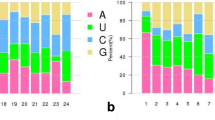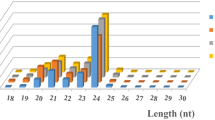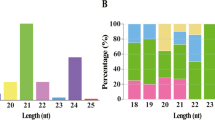Abstract
MicroRNAs (miRNAs) play important regulatory roles in plant development and stress responses. Tomato is an economically important vegetable crop in the world with publicly available genomic information database, but only a limited number of tomato miRNAs have been identified. In this study, two independent small RNA libraries from mock and Cucumber mosaic virus (CMV)-infected tomatoes were constructed, respectively, and sequenced with a high-throughput Illumina Solexa system. Based on sequence analysis and hairpin structure prediction, a total of 50 plant miRNAs and 273 potentially candidate miRNAs (PC-miRNAs) were firstly identified in tomato, with 12 plant miRNAs and 82 PC-miRNAs supported by both the 3p and 5p strands. Comparative analysis revealed that 79 miRNAs (including 15 new tomato miRNAs) and 40 PC-miRNAs were differentially expressed between the two libraries, and the expression patterns of some new tomato miRNAs and PC-miRNAs were further validated by qRT-PCR. Moreover, potential targets for some of the known and new tomato miRNAs were identified by the recently developed degradome sequencing approach, and target annotation indicated that they were involved in multiple biological processes, including transcriptional regulation and virus resistance. Gene ontology analysis of these target transcripts demonstrated that defense response- and photosynthesis-related genes were most affected in CMV-Fny-infected tomatoes. Because tomato is not only an important crop but also is a genetic model for basic biology research, our study contributes to the understanding of miRNAs in response to virus infection.




Similar content being viewed by others
Abbreviations
- CMV:
-
Cucumber mosaic virus
- AGO:
-
Argonaute
- DCL:
-
Dicer-like
- nt:
-
Nucleotide
- miRNA:
-
MicroRNA
- siRNA:
-
Small interfering RNA
- pri-miRNA:
-
Primary miRNA
- pre-miRNA:
-
miRNA precursor
- RISC:
-
RNA-induced silencing complex
- dpi:
-
Days post-inoculation
- MFEI:
-
Minimal folding free energy index
- PC-miRNA:
-
Potential candidate miRNA
- qRT-PCR:
-
Reverse transcription-quantitative polymerase chain reaction
- C t :
-
Threshold cycle
- T-plots:
-
Target plots
- GO:
-
Gene ontology
References
Addo-Quaye C, Eshoo TW, Bartel DP, Axtell MJ (2008) Endogenous siRNA and miRNA targets identified by sequencing of the Arabidopsis degradome. Curr Biol 18:758–762
Addo-Quaye C, Miller W, Axtell MJ (2009a) CleaveLand: a pipeline for using degradome data to find cleaved small RNA targets. Bioinformatics 25:130–131
Addo-Quaye C, Snyder JA, Park YB, Li YF, Sunkar R et al (2009b) Sliced microRNA targets and precise loop-first processing of MIR319 hairpins revealed by analysis of the Physcomitrella patens degradome. RNA 15:2112–2121
Allen E, Xie ZX, Gustafson AM, Carrington JC (2005) MicroRNA-directed phasing during Trans-Acting siRNA biogenesis in plants. Cell 121:207–221
Ambros V, Bartel B, Bartel DP, Burge CB, Carrington JC et al (2003) A uniform system for microRNA annotation. RNA 9:277–279
Axtell MJ, Bowman JL (2008) Evolution of plant microRNAs and their targets. Trends Plant Sci 13:343–349
Bartel DP (2004) MicroRNAs: genomics, biogenesis, mechanism, and function. Cell 116:281–297
Baumberger N, Baulcombe DC (2005) Arabidopsis ARGONAUTE1 is an RNA slicer that selectively recruits microRNAs and short interfering RNAs. Proc Natl Acad Sci USA 102:11928–11933
Bilgin DD, Zavala JA, Zhu J, Clough SJ, Ort DR, Delucia EH (2010) Biotic stress globally down regulates photosynthesis genes. Plant Cell Environ 33:1597–1613
Brodersen P, Voinnet O (2006) The diversity of RNA silencing pathways in plants. Trends Genet 22:268–280
Brodersen P, Sakvarelidze-Achard L, Bruun-Rasmussen M, Dunoyer P, Yamamoto YY et al (2008) Widespread translational inhibition by plant miRNAs and siRNAs. Science 320:1185–1190
Chen CF, Ridzon DA, Broomer AJ, Zhou ZH, Lee DH et al (2005) Real-time quantification of microRNAs by stem-loop RT-PCR. Nucleic Acids Res 33:e179
Chen L, Wang T, Zhao M, Tian Q, Zhang WH (2012a) Identification of aluminum-responsive microRNAs in Medicago truncatula by genome-wide high-throughput sequencing. Planta 235:375–386
Chen L, Zhang Y, Ren Y, Xu J, Zhang Z et al (2012b) Genome-wide identification of cold-responsive and new microRNAs in Populus tomentosa by high-throughput sequencing. Biochem Biophys Res Commun 417:892–896
Ding SW, Voinnet O (2007) Antiviral immunity directed by small RNAs. Cell 130:413–426
Du Z, Zhou X, Ling Y, Zhang Z, Su Z (2010) AgriGO: a GO analysis toolkit for the agricultural community. Nucleic Acids Res 38:gkq310
Edgar R, Domrachev M, Lash AE (2002) Gene Expression Omnibus: NCBI gene expression and hybridization array data repository. Nucl Acids Res 30:207–210
Feng JL, Lin RH, Chen JS (2013a) Alteration of tomato microRNAs expression during fruit development upon Cucumber mosaic virus and Tomato aspermy virus infection. Mol Biol Rep 40:3713–3722
Feng JL, Wang YW, Lin RH, Chen JS (2013b) Altered expression of microRNAs and target mRNAs in tomato root and stem tissues upon different viral infection. J Phytopathol 161:107–119
García-Arenal F, Escriu F, Aranda MA, Alonso-Prados JL, Malpica JM et al (2000) Molecular epidemiology of Cucumber mosaic virus and its satellite RNA. Virus Res 71:1–8
German MA, Luo SJ, Schroth G, Meyers BC, Green PJ (2009) Construction of parallel analysis of RNA ends (PARE) libraries for the study of cleaved miRNA targets and the RNA degradome. Nat Protoc 4:356–362
Horwich AL (2011) Protein folding in the cell: an inside story. Nat Med 17:1211–1216
Huber W, von Heydebreck A, Sultmann H, Poustka A, Vingron M (2002) Variance stabilization applied to microarray data calibration and to the quantification of differential expression. Bioinformatics 18:S96–S104
Jacquemond M (2012) Cucumber mosaic virus. Adv Virus Res 84:439–504
Jeong DH, Park S, Zhai J, Gurazada SGR, De Paoli E et al (2011) Massive analysis of rice small RNAs: mechanistic implications of regulated microRNAs and variants for differential target RNA cleavage. Plant Cell 23:4185–4207
Jones-Rhoades MW, Bartel DP, Bartel B (2006) MicroRNAs and their regulatory roles in plants. Annu Rev Plant Biol 57:19–53
Kurihara Y, Watanabe Y (2004) Arabidopsis micro-RNA biogenesis through Dicer-like 1 protein functions. Proc Natl Acad Sci USA 101:12753–12758
Lelandais-Briere C, Naya L, Sallet E, Calenge F, Frugier F et al (2009) Genome-wide Medicago truncatula small RNA analysis revealed novel microRNAs and isoforms differentially regulated in roots and nodules. Plant Cell 21:2780–2796
Li H, Dong Y, Yin H, Wang N, Yang J et al (2011) Characterization of the stress associated microRNAs in Glycine max by deep sequencing. BMC Plant Biol 11:170
Li F, Pignatta D, Bendix C, Brunkard JO, Cohn MM et al (2012) MicroRNA regulation of plant innate immune receptors. Proc Natl Acad Sci USA 109:1790–1795
Lim PO, Lee IC, Kim J, Kim HJ, Ryu JS et al (2010) Auxin response factor 2 (ARF2) plays a major role in regulating auxin-mediated leaf longevity. J Exp Bot 61:1419–1430
Lopez-Gomollon S, Mohorianu I, Szittya G, Moulton V, Dalmay T (2012) Diverse correlation patterns between microRNAs and their targets during tomato fruit development indicates different modes of microRNA actions. Planta 236:1875–1887
Lu C, Shedge V (2011) Construction of small RNA cDNA libraries for high-throughput sequencing. Methods Mol Biol 729:141–152
Manfre A, Glenn M, Nunez A, Moreau RA, Dardick C (2011) Light quantity and photosystem function mediate host susceptibility to Turnip mosaic virus via a salicylic acid-independent mechanism. Mol Plant Microbe Interact 24:315–327
Marathe R, Guan Z, Anandalakshmi R, Zhao H, Dinesh-Kumar SP (2004) Study of Arabidopsis thaliana resistome in response to Cucumber mosaic virus infection using whole genome microarray. Plant Mol Biol 55:501–520
Maule A, Leh V, Lederer C (2002) The dialogue between viruses and hosts in compatible interactions. Curr Opin Plant Biol 5:279–284
Mestdagh P, Feys T, Bernard N, Guenther S, Chen C, Speleman F, Vandesompele J (2008) High-throughput stem-loop RT-qPCR miRNA expression profiling using minute amounts of input RNA. Nucleic Acids Res 36:e143
Meyers BC, Axtell MJ, Bartel B, Bartel DP, Baulcombe D et al (2008) Criteria for annotation of plant microRNAs. Plant Cell 20:3186–3190
Mochizuki T, Ogata Y, Hirata Y, Ohki ST (2013) Quantitative transcriptional changes associated with chlorosis severity in mosaic leaves of tobacco plants infected with Cucumber mosaic virus. Mol Plant Pathol 15:242–254
Mohorianu I, Schwach F, Jing R, Lopez-Gomollon S, Moxon S et al (2011) Profiling of short RNAs during fleshy fruit development reveals stage-specific sRNAome expression patterns. Plant J 67:232–246
Moreno-Risueno MA, Van Norman JM, Moreno A, Zhang J, Ahnert SE et al (2010) Oscillating gene expression determines competence for periodic Arabidopsis root branching. Science 329:1306–1311
Moxon S, Jing R, Szittya G, Schwach F, Rusholme Pilcher RL et al (2008) Deep sequencing of tomato short RNAs identifies microRNAs targeting genes involved in fruit ripening. Genome Res 18:1602–1609
Oldroyd GE, Staskawicz BJ (1998) Genetically engineered broad-spectrum disease resistance in tomato. Proc Natl Acad Sci USA 95:10300–10305
Pantaleo V, Szittya G, Moxon S, Miozzi L, Moulton V et al (2010) Identification of grapevine microRNAs and their targets using high throughput sequencing and degradome analysis. Plant J 62:960–976
Roossinck MJ (2013) Plant virus ecology. PLoS Pathog 9:e1003304
Scarpella E, Barkoulas M, Tsiantis M (2010) Control of leaf and vein development by auxin. Cold Spring Harb Perspect Biol 2:a001511
Shimura H, Pantaleo V, Ishihara T, Myojo N, Inaba J et al (2011) A viral satellite RNA induces yellow symptoms on tobacco by targeting a gene involved in chlorophyll biosynthesis using the RNA silencing machinery. PLoS Pathog 7:e1002021
Sikora EJ, Gudauskas RT, Murphy JF, Porch DW, Andrianifahanana M et al (1998) A multivirus epidemic of tomatoes in Alabama. Plant Dis 82:117–120
Smith NA, Eamens AL, Wang M-B (2011) Viral siRNAs target host genes to mediate disease symptoms in plants. PLoS Pathog 7:e1002022
Spoel SH, Koornneef A, Claessens SMC, Korzelius JP, Van Pelt JA et al (2003) NPR1 modulates cross-talk between salicylate-and jasmonate-dependent defense pathways through a novel function in the cytosol. Plant Cell 15:3760–3770
Todesco M, Rubio-Somoza I, Paz-Ares J, Weigel D (2010) A collection of target mimics for comprehensive analysis of microRNA function in Arabidopsis thaliana. PLoS Genet 6:e1001031
van Ooijen G, van den Burg HA, Cornelissen BJ, Takken FL (2007) Structure and function of resistance proteins in solanaceous plants. Annu Rev Phytopathol 45:43–72
van Rooij E (2011) The art of microRNA research. Circ Res 108:219–234
Wang T, Chen L, Zhao M, Tian Q, Zhang W (2011) Identification of drought responsive microRNAs in Medicago truncatula by genome-wide high throughput sequencing. BMC Genom 12:367
Wang CM, Shi DJ, Zhu SF, Yie Y, Tien P, Wei NS (2013) Expression of the CMV-CP gene in Synechocystis 6803 affects cyanobacterial photosynthesis. J Phytopathol 161:263–270
Wollmann H, Mica E, Todesco M, Long JA, Weigel D (2010) On reconciling the interactions between APETALA2, miR172 and AGAMOUS with the ABC model of flower development. Development 137:3633–3642
Wu G, Park MY, Conway SR, Wang JW, Weigel D et al (2009) The sequential action of miR156 and miR172 regulates developmental timing in Arabidopsis. Cell 138:750–759
Xie FL, Frazier TP, Zhang BH (2011) Identification, characterization and expression analysis of microRNAs and their targets in the potato (Solanum tuberosum). Gene 473:8–22
Xu P, Chen F, Mannas JP, Feldman T, Sumner LW, Roossinck MJ (2008) Virus infection improves drought tolerance. New Phytol 180:911–921
Yang J, Liu X, Xu B, Zhao N, Yang X, Zhang M (2013) Identification of miRNAs and their targets using high-throughput sequencing and degradome analysis in cytoplasmic male-sterile and its maintainer fertile lines of Brassica juncea. BMC Genom 14:9
Yin ZJ, Li CH, Han ML, Shen FF (2008) Identification of conserved microRNAs and their target genes in tomato (Lycopersicon esculentum). Gene 414:60–66
Zeng QY, Yang CY, Ma QB, Li XP, Dong WW et al (2012) Identification of wild soybean miRNAs and their target genes responsive to aluminum stress. BMC Plant Biol 12:182
Zhang BH, Pan XP, Cox SB, Cobb GP, Anderson TA (2006) Evidence that miRNAs are different from other RNAs. Cell Mol Life Sci 63:246–254
Zhang J, Zeng R, Chen J, Liu X, Liao Q (2008) Identification of conserved microRNAs and their targets from Solanum lycopersicum Mill. Gene 423:1–7
Zuker M (2003) Mfold web server for nucleic acid folding and hybridization prediction. Nucleic Acids Res 31:3406–3415
Acknowledgments
This work was supported by the grants from the National Natural Science Foundation of China (30800716) and the Science Foundation of Zhejiang Sci-Tech University (ZSTU) under Grant No. 1016816-Y.
Author information
Authors and Affiliations
Corresponding author
Electronic supplementary material
Below is the link to the electronic supplementary material.
Supplementary Table S1
Primers used for qRT-PCR in this study. Supplementary material 1 (XLS 48 kb)
Supplementary Table S2
Profile of the known tomato microRNAs (miRBase 20.0) identified in this study. Supplementary material 2 (XLS 96 kb)
Supplementary Table S3
Profile of microRNAs originating from other plant pre-miRNAs (miRBase 20.0) that can be mapped to tomato genome. Supplementary material 3 (XLS 70 kb)
Supplementary Table S4
Profile of microRNAs originating from pre-miRNAs that cannot be mapped to tomato genome, but the microRNAs were mapped to tomato genome and the extended sequences at the mapped positions of the genome potentially form hairpins. Supplementary material 4 (XLS 85 kb)
Supplementary Table S5
50 new tomato miRNAs belonging to 32 known plant miRNA families identified in this study. Supplementary material 5 (XLS 70 kb)
Supplementary Table S6
Profile of candidate miRNAs originating from predicted RNA hairpins (PC-type pre-miRNAs). Supplementary material 6 (XLS 141 kb)
Supplementary Table S7
82 PC-miRNAs were identified with both the 3p and 5p strands in this study. Supplementary material 7 (XLS 86 kb)
Supplementary Table S8
Profile of differently expressed microRNAs between the two libraries. Supplementary material 8 (XLS 105 kb)
Supplementary Table S9
Profile of PC-miRNAs, which were differently expressed between the two libraries. Supplementary material 9 (XLS 75 kb)
Supplementary Table S10
Targets of all tomato miRNAs identified in this study and their function verified by degradome sequencing. Supplementary material 10 (XLS 157 kb)
Supplementary Table S11
Function for the targets of new tomato miRNAs and PC-miRNAs verified by degradome sequencing. Supplementary material 11 (XLS 81 kb)
Supplementary Table S12
GO analyses of the targets for known and new tomato miRNAs. Supplementary material 12 (XLS 1,801 kb)
Rights and permissions
About this article
Cite this article
Feng, J., Liu, S., Wang, M. et al. Identification of microRNAs and their targets in tomato infected with Cucumber mosaic virus based on deep sequencing. Planta 240, 1335–1352 (2014). https://doi.org/10.1007/s00425-014-2158-3
Received:
Accepted:
Published:
Issue Date:
DOI: https://doi.org/10.1007/s00425-014-2158-3




